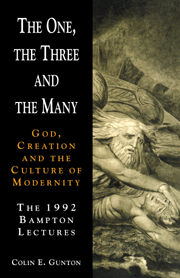Book contents
- Frontmatter
- Contents
- Preface
- Introduction
- PART ONE THE DISPLACEMENT OF GOD
- PART TWO RETHINKING CREATEDNESS
- 5 The universal and the particular. Towards a theology of meaning and truth
- 6 ‘Through whom and in whom …’ Towards a theology of relatedness
- 7 The Lord who is the Spirit. Towards a theology of the particular
- 8 The triune Lord. Towards a theology of the one and the many
- Bibliography
- Index
6 - ‘Through whom and in whom …’ Towards a theology of relatedness
Published online by Cambridge University Press: 05 June 2012
- Frontmatter
- Contents
- Preface
- Introduction
- PART ONE THE DISPLACEMENT OF GOD
- PART TWO RETHINKING CREATEDNESS
- 5 The universal and the particular. Towards a theology of meaning and truth
- 6 ‘Through whom and in whom …’ Towards a theology of relatedness
- 7 The Lord who is the Spirit. Towards a theology of the particular
- 8 The triune Lord. Towards a theology of the one and the many
- Bibliography
- Index
Summary
RECAPITULATION
In Chapter 3, I discussed the question of relationality, of the way in which things hold together in the world, by an examination of the way in which in the modern world we understand our habitation of the world of time. I argued that the displacement of God that is so marked a feature of modernity brought it about that we enter a tyranny of time which alienates us from our past and disrupts our present. In this chapter, I take up aspects of the theme adumbrated there. Can there be a rebuilding on the new theological foundations suggested by the trinitarian open transcendentals? Let me begin by saying that one of the functions of the concepts of time and space is to give a measure of unity to our experience of the world. By using the concept of time, we are able to relate things as before and after, and thus as belonging in some kind of order. Similarly, the concept of space enables us to conceive a different but related form of order and to understand the various realities we experience as belonging in some way together although they are distinct from one another. Some uses of the concepts take us into theology. For example Newton's conceptions of absolute space and time go beyond immediate experience into metaphysics. The changes in Newton's understanding of these concepts, as charted by Blumenberg, for example, suggest that he was not himself sure of the function the concepts were supposed to perform.
- Type
- Chapter
- Information
- The One, the Three and the Many , pp. 155 - 179Publisher: Cambridge University PressPrint publication year: 1993

